- Active Investing - what is it?
- All Weather Trading Plan using Complex Theory (Parts 1 - 4)
- Asset Management (Parts 1 - 4)
- Back Testing
- Breaking out from consolidation
- Breakout trading in all market conditions
- Charting in a Nutshell
- Children of the Bear
- Fibonacci and the Golden Ratio
- Going Public
- Hull Moving Average
- MACD Breakout Trading (Parts 1 - 2)
- Making decisions with a Simple Moving Average
- Probability: do you have the stomach for it?
- Profit Taking
- Relative Strength
- Record Keeping
- Risky Business
- Short Selling
- Social Media Bubble
- Switching Gears
- Rate of Return indicator
- Time and Money
- Tools of the Trade
- Trade Warrants (Parts 1 - 4)
- Trading without spending money
- Trendlines
- Triangles
- GMMA's on Weekly Charts
- Writing Custom Indicators
Articles include:
My first pushbike was a fairly basic affair with no accessories, save for a bell. It had the old fashioned foot-brake that activated when you pedaled backwards. Some of my friends owned the more fancy Dragstar bicycles of the time that sported handbrakes and, wait for it... 3 speed gears. The gear levers were usually positioned on the main cross-bar where even the most casual observer could not fail to see this highly sort-after accessory. But what made me green with envy was the fact that, unlike myself, my friends didn't have to dismount their suburban steeds when a hill appeared in front of them. I still have visions of walking my bike up hills.
Today, thanks to a more liberal budget and the advancement of bicycle technology, I own a mountain bike that sports an incredible 24 gears. I can't actually claim to have used all 24 gears but I can claim to have ridden my Yukon (pictured below) up a staircase... a feat that is largely possible thanks to the brilliant design of the bike as opposed to my riding prowess.

Now you're probably wondering what this all has to do with share trading, etc. Well... imagine that you owned a bicycle that had gears but you never bothered to use them. Not a very likely scenario but one that is all too common when it comes to modern charting software. All modern charting programs have gears... 3 to be precise. They are daily, weekly and monthly and you can switch gears (timeframes) at the press of a button... or should I say 'Radio button'.

The reason why most chartist's don't switch gears is because they don't see any advantage in it.
Or, if I was to be more cynical, I would probably suggest that there are very few chartist's who actually know how to use their gears. But that definitely won't apply to you after you've read the remainder of this article, which explains the nature of each gear. What's more, the next article in this series will start to examine a range of strategies that will help you get up all of the steep hills that you're likely to run into when touring around the Stockmarket with your hard earned cash. But for now we will content ourselves with a closer look at the properties of each timeframe, including both advantages and disadvantages. Of course we'll start with first gear.
Monthly
To learn to drive a car, most of us just toured around the local shopping centre car park during a lazy Sunday afternoon, rarely getting the transmission beyond second gear. You didn't have to make quick decisions and if an obstacle did present itself, a leisurely response was all that was required. Although very few people learn to trade in a monthly timeframe, it is the preferred place to start if you're looking for the equivalent to a first gear in the Stockmarket.Share trading using monthly price charts means plenty of time for decision-making, mistakes will usually prove to be less costly and any obstacles such as S11 will have a reduced impact. Of course fundamental analysis does come into the picture when trading on a monthly basis, as a company's financial performance will have an impact on its share price performance over this timeframe. The disadvantages are (1) the boredom factor and (2) the reduced returns that can be achieved in this timeframe... although returns of up to 100% per annum are possible.

Although it's been a bumpy ride, the monthly trend in Bendigo Bank has weathered the likes of S11 fairly admirably to give an annualised return over the past 2 years of approximately 25%. This is the Stockmarket's first gear that will get you up and over hills without you having to take your money out of the market. (I have included the 30 period moving average in order to give you a point of comparison when comparing the same equity over the 3 different timeframes.)
Weekly
This is the Market's midrange gear (my favourite) and it's a compromise in every respect. Not too hot, not too cold, not too hard & not too soft... it's Goldilocks favourite also. But it does lack the hill climbing capabilities of 1st gear (read monthly) as the following chart illustrates.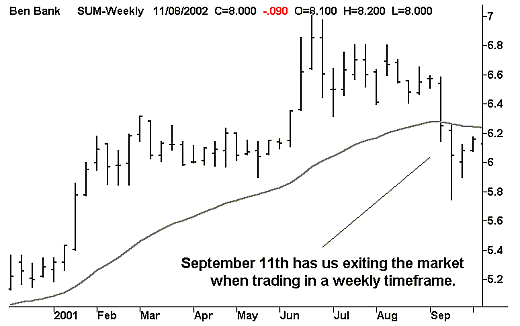
Daily
This is where most Traders learn their craft and the reason why the majority fail... the Market's equivalent of top gear. The advantages are increased profitability and the ability to ignore external factors such as a company's financial performance... if that's an advantage. The disadvantages are less time to think and increased volatility... assuming that's a disadvantage.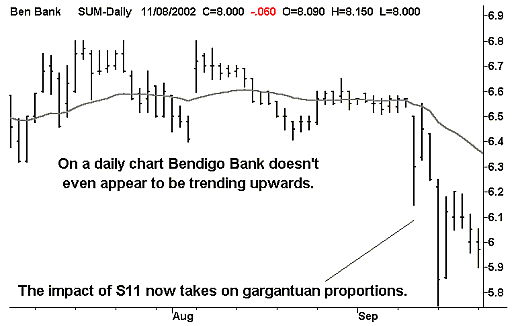
The previous article looked at the unique properties of the 3 different timeframes that our charting software allows us to operate in... being daily, weekly and monthly. Now that we have a better understanding of this 3 speed transmission its time to start looking at the benefits of 'Switching gears'. But before we do, it pays to note that all charting techniques work in any timeframe, ie. the MACD Indicator works just as well on monthly charts as it does on daily or weekly charts. So the charting skills you acquire in one timeframe are applicable in all others.
Horses for Courses
Years ago I was invited to participate in a corporate evening at a Super-Kart Racetrack. Although I have always had a keen interest in cars, having owned several Classic Cars and possessing an automotive library that rivals my collection of books on share trading, I discovered on this particular night that I'm no racing car driver. I just don't have the psyche for it. Whilst I could do a 'Hot lap' with the best of them, I found it very difficult to maintain the required mental intensity for any period of time and, what's more, I didn't enjoy having to do so.I'm an analyst at heart and I like to sit and think. Whilst I occasionally jump onto the cutting edge of intraday derivative trading, the mainstay of my market approach is weekly charts. I operate in shorter timeframes if and when it suits me and rarely for extended periods of time. The bottom line is that I trade according to my personality and I don't let anyone push me out of my comfort zone... or entice me out of it with 'Get Rich Quick' promises. So I obviously recommend that same approach to everyone else... drive around the Market at your own speed.
The Acid Test
Question - When is a trend really a trend? Answer - when all timeframes agree that it is.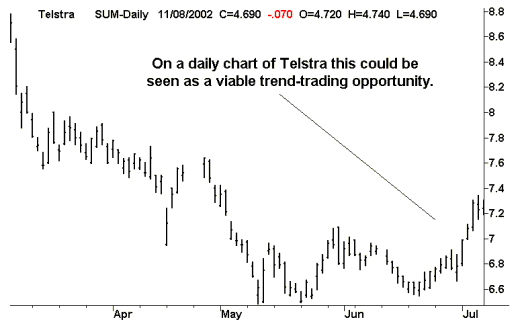
Of course there is no definitive answer to this question but the answer given above makes for a good acid test. The simple message here is don't get hit in the back of the head by the Traders and/or Investors that are operating in the next timeframe. You can clearly see in the above chart of Telstra that there is a large downtrend lurking just behind our potential uptrend. To really test the viability of our uptrend, all we have to do is switch down a gear and take another look.
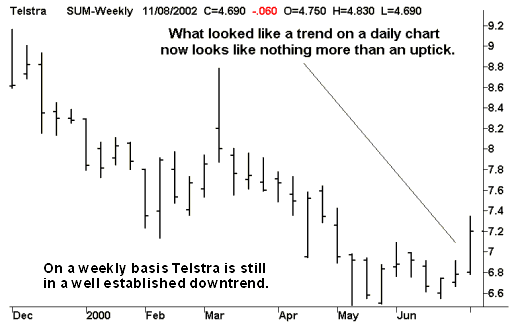
Whilst we may be looking at the start of a new trend it makes far more sense to trade a daily uptrend within a weekly uptrend. Trying to 'Get in early' is speculating... not share trading!!!
So just before you're about to commit your hard earned cash to a trade, switch down a gear and check things out. The Stockmarket is a democracy where '$1 = 1 vote' and being in the minority can be very expensive. To this end, it literally pays to make sure that the majority of market participants agree with your analysis. The Stockmarket is not the place to try and be different.
Double Clutching Down
Anyone who has ever driven a manual car will be familiar with the 'Chug chug' of an over-torqued engine when it is trying to struggle up a hill in a gear that is too tall for the job. The solution of course is to select a lower gear and increase the engine revs... an act that used to require double-clutching before the advent of all-synchro gearboxes.Experienced Traders use a very similar tactic to get themselves out of trouble in the Stockmarket. Imagine you're trading a share on a daily basis and, heaven forbid, you failed to execute a stop loss when it was breached... OOPS. You can sometimes get yourself out of this nasty predicament by switching gears to the next timeframe which will cause the stop loss to 'Widen out'... normally a big no-no. The following charts show how this tactic works when applying the Range Indicator to the same equity in two different timeframes.

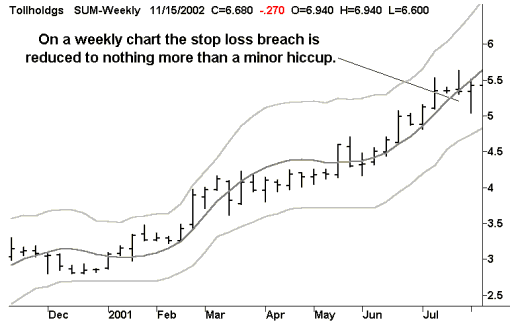
A couple of very important points to note (1) the share must be in an uptrend in the timeframe you are switching to, ie. it must be a valid trade on its own merits, and (2) experienced Traders do not use this tactic to avoid executing their stop losses. The next article in this series will look at how we can exploit different timeframes to increase the number of trading opportunities available to us...a neat trick in a tight market.
Previously in this article I advised readers to determine which timeframe, or gear, they feel most comfortable with and to stick to it (see: Horses for Courses above). But if there are no tradeable opportunities in your chosen timeframe then you will be left with little choice but to either sit on the sidelines with your money in the bank or 'Switch gears' in order to find some potential trading candidates. It is an unfortunate reality when you're trading shares, or fishing for that matter, that you have to seek out potential opportunities, as they rarely come to you.
Each gear - daily, weekly or monthly - offers different trading opportunities. A share that is trending down in one timeframe may in fact be trending up in another, broader timeframe. But when we switch gears in search of trading opportunities, we must always advance through the gears from daily to weekly to monthly and never in the opposite direction. This is because we never want to be caught counter-trending the Traders/Investors who are operating in a broader timeframe than ourselves (see: The Acid Test above).
The best way to illustrate the effectiveness of this technique is with an example. It would take a very liberal interpretation of the following chart to conclude that Gunns (GNS), is trending upwards. In fact, on a daily basis, Gunns definitely wouldn't be given a second look...
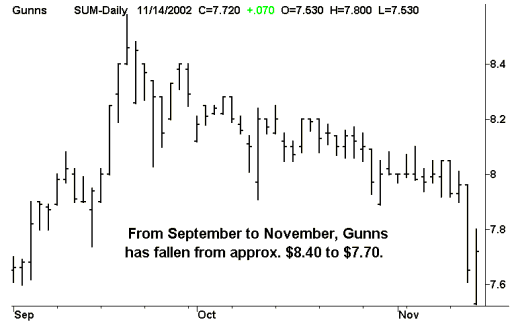
... unless, of course, you were scanning the market for potential 'Short selling' opportunities. But if short selling isn't your cup of tea then the only option available is to switch down a gear, to a weekly chart, and take another look.
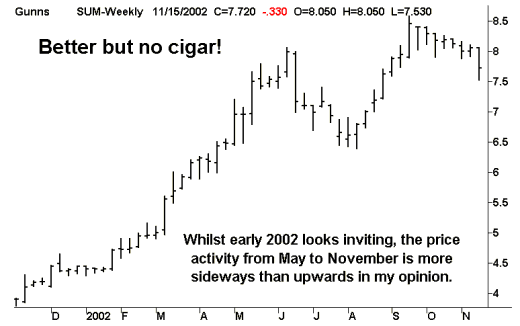
However it's third time lucky when we switch down another gear to a monthly chart.
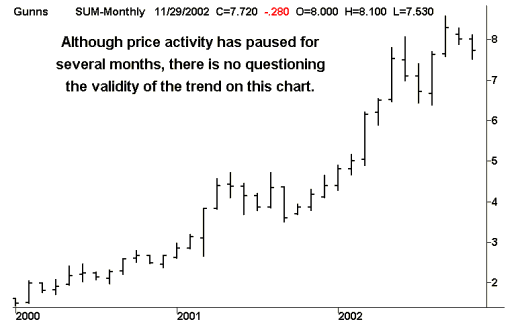
And, on a final note... there is no law that says you can't be operating in different timeframes for different equities at the same time. But make sure that you don't get your gears mixed up because, unlike driving a car, selecting the wrong gear in the Stockmarket can mean more than just stalling the engine.